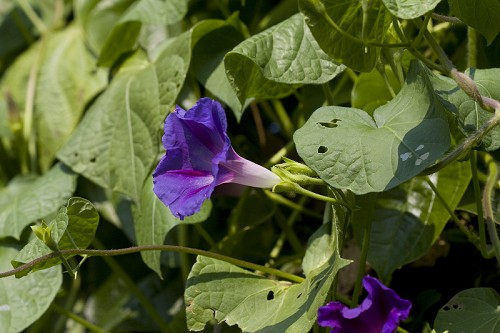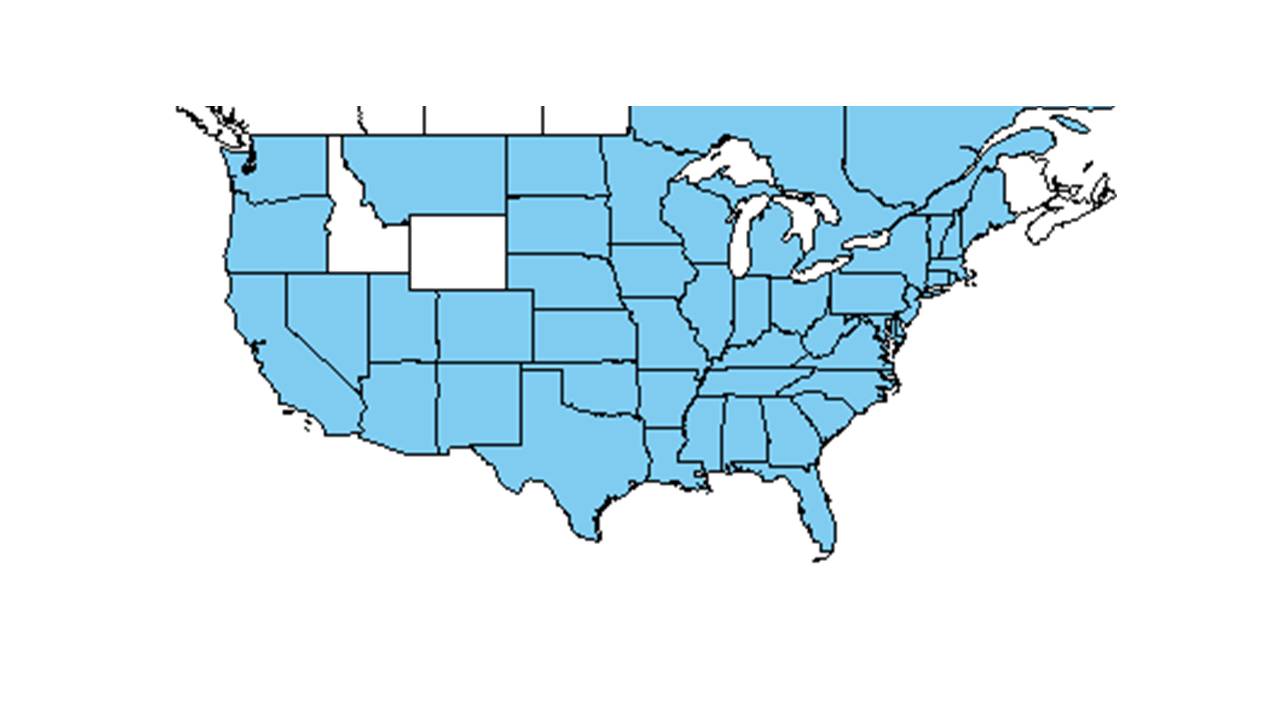Difference between revisions of "Ipomoea purpurea"
(→Description) |
HaleighJoM (talk | contribs) (→Ecology) |
||
| (26 intermediate revisions by 6 users not shown) | |||
| Line 3: | Line 3: | ||
{{taxobox | {{taxobox | ||
| name = Ipomoea purpurea | | name = Ipomoea purpurea | ||
| − | | image = | + | | image = Ipom_purp.jpg |
| − | | image_caption = | + | | image_caption = Photo by John R. Gwaltney, [http://www.southeasternflora.com/index.asp Southeastern Flora.com] |
| regnum = Plantae | | regnum = Plantae | ||
| divisio = Magnoliophyta - Flowering plants | | divisio = Magnoliophyta - Flowering plants | ||
| Line 17: | Line 17: | ||
| range_map_caption = Natural range of ''Ipomoea purpurea'' from USDA NRCS [http://www.plants.usda.gov Plants Database]. | | range_map_caption = Natural range of ''Ipomoea purpurea'' from USDA NRCS [http://www.plants.usda.gov Plants Database]. | ||
}} | }} | ||
| + | |||
| + | Common names: Tall morning-glory, Common morning-glory.<ref name="weakley">Weakley, A.S. 2015. Flora of the southern and mid-atlantic states. Working Draft of 21 May 2015. University of North Carolina at Chapel Hill, Chapel Hill, North Carolina.</ref> | ||
| + | |||
| + | ==Taxonomic notes== | ||
| + | Synonyms: ''Pharbitis purpurea'' (Linnaeus) Voigt.<ref name="weakley">Weakley, A.S. 2015. Flora of the southern and mid-atlantic states. Working Draft of 21 May 2015. University of North Carolina at Chapel Hill, Chapel Hill, North Carolina.</ref> | ||
| + | |||
| + | Varieties: none.<ref name="weakley">Weakley, A.S. 2015. Flora of the southern and mid-atlantic states. Working Draft of 21 May 2015. University of North Carolina at Chapel Hill, Chapel Hill, North Carolina.</ref> | ||
| + | |||
==Description== | ==Description== | ||
<!-- Basic life history facts such as annual/perrenial, monoecious/dioecious, root morphology, seed type, etc. --> | <!-- Basic life history facts such as annual/perrenial, monoecious/dioecious, root morphology, seed type, etc. --> | ||
| − | |||
| − | + | This plant is a vine and is common within its range.<ref name="FSU Herbarium">Florida State University Robert K. Godfrey Herbarium database. URL: [http://herbarium.bio.fsu.edu http://herbarium.bio.fsu.edu]. Last accessed: June 2014. Collectors: Robert K. Godfrey, Leon Neel, Edwin L. Tyson, Loran C. Anderson, T. MacClendon, and Karen MacClendon. States and Counties: Florida: Calhoun, Jackson, and Leon. Countries: Panama.</ref> | |
==Distribution== | ==Distribution== | ||
| + | ''I. purpurea'' is a native of tropical America.<ref name="weakley">Weakley, A.S. 2015. Flora of the southern and mid-atlantic states. Working Draft of 21 May 2015. University of North Carolina at Chapel Hill, Chapel Hill, North Carolina.</ref> | ||
| + | |||
==Ecology== | ==Ecology== | ||
===Habitat=== <!--Natural communities, human disturbed habitats, topography, hydrology, soils, light, fire regime requirements for removal of competition, etc.--> | ===Habitat=== <!--Natural communities, human disturbed habitats, topography, hydrology, soils, light, fire regime requirements for removal of competition, etc.--> | ||
| − | This species has been found in disturbed habitats along the edges of soybean fields, on farms, and along roadsides in loamy clay | + | This species has been found in disturbed habitats along the edges of soybean fields, on farms, and along roadsides in loamy clay.<ref name="FSU Herbarium"/> |
===Phenology=== <!--Timing off flowering, fruiting, seed dispersal, and environmental triggers. Cite PanFlora website if appropriate: http://www.gilnelson.com/PanFlora/ --> | ===Phenology=== <!--Timing off flowering, fruiting, seed dispersal, and environmental triggers. Cite PanFlora website if appropriate: http://www.gilnelson.com/PanFlora/ --> | ||
| − | This species has been observed to flower in June and October | + | This species has been observed to flower with a deep magenta-red with a white throat in July, June, and October.<ref>Nelson, G. [http://www.gilnelson.com/ PanFlora]: Plant data for the eastern United States with emphasis on the Southeastern Coastal Plains, Florida, and the Florida Panhandle. www.gilnelson.com/PanFlora/ Accessed: 12 DEC 2016</ref><ref name="FSU Herbarium"/> |
| + | <!--===Seed dispersal===--> | ||
| + | <!--===Seed bank and germination===--> | ||
| + | <!--===Fire ecology===--> <!--Fire tolerance, fire dependence, adaptive fire responses--> | ||
| + | <!--===Pollination===--> | ||
| + | <!--===Herbivory and toxicology===--> <!--Herbivory, granivory, insect hosting, etc.--> | ||
| + | <!--===Diseases and parasites===--> | ||
| + | |||
| + | ==Conservation, cultivation, and restoration== | ||
| + | |||
| + | ==Cultural use== | ||
| + | When chewed the seeds are a hallucinogen, but this is incredibly dangerous to practice. The rest of the plant has been used as a strong laxative.<ref> Korchmal, Arnold & Connie. 1973. A Guide to the Medicinal Plants of the United States. The New York Times Book Company, New York.</ref> | ||
| − | |||
| − | |||
| − | |||
| − | |||
| − | |||
| − | |||
| − | |||
| − | |||
==Photo Gallery== | ==Photo Gallery== | ||
| + | <gallery widths=180px> | ||
| + | File: Ipom_purp_Flower-JGwaltney-SEFlora.jpg | <Center> ''Ipomoea purpurea'' flower <p> Photo by John R. Gwaltney, [http://www.southeasternflora.com/index.asp Southeastern Flora.com] </gallery> | ||
==References and notes== | ==References and notes== | ||
Latest revision as of 12:29, 13 July 2022
| Ipomoea purpurea | |
|---|---|

| |
| Photo by John R. Gwaltney, Southeastern Flora.com | |
| Scientific classification | |
| Kingdom: | Plantae |
| Division: | Magnoliophyta - Flowering plants |
| Class: | Magnoliopsida – Dicotyledons |
| Order: | Solanales |
| Family: | Convolvulaceae |
| Genus: | Ipomoea |
| Species: | I. purpurea |
| Binomial name | |
| Ipomoea purpurea (L.) Roth | |

| |
| Natural range of Ipomoea purpurea from USDA NRCS Plants Database. | |
Common names: Tall morning-glory, Common morning-glory.[1]
Contents
Taxonomic notes
Synonyms: Pharbitis purpurea (Linnaeus) Voigt.[1]
Varieties: none.[1]
Description
This plant is a vine and is common within its range.[2]
Distribution
I. purpurea is a native of tropical America.[1]
Ecology
Habitat
This species has been found in disturbed habitats along the edges of soybean fields, on farms, and along roadsides in loamy clay.[2]
Phenology
This species has been observed to flower with a deep magenta-red with a white throat in July, June, and October.[3][2]
Conservation, cultivation, and restoration
Cultural use
When chewed the seeds are a hallucinogen, but this is incredibly dangerous to practice. The rest of the plant has been used as a strong laxative.[4]
Photo Gallery
Ipomoea purpurea flower Photo by John R. Gwaltney, Southeastern Flora.com
References and notes
- ↑ 1.0 1.1 1.2 1.3 Weakley, A.S. 2015. Flora of the southern and mid-atlantic states. Working Draft of 21 May 2015. University of North Carolina at Chapel Hill, Chapel Hill, North Carolina.
- ↑ 2.0 2.1 2.2 Florida State University Robert K. Godfrey Herbarium database. URL: http://herbarium.bio.fsu.edu. Last accessed: June 2014. Collectors: Robert K. Godfrey, Leon Neel, Edwin L. Tyson, Loran C. Anderson, T. MacClendon, and Karen MacClendon. States and Counties: Florida: Calhoun, Jackson, and Leon. Countries: Panama.
- ↑ Nelson, G. PanFlora: Plant data for the eastern United States with emphasis on the Southeastern Coastal Plains, Florida, and the Florida Panhandle. www.gilnelson.com/PanFlora/ Accessed: 12 DEC 2016
- ↑ Korchmal, Arnold & Connie. 1973. A Guide to the Medicinal Plants of the United States. The New York Times Book Company, New York.
